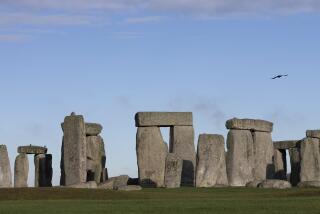Does N.H. Stonehenge Predate Columbus?
- Share via
SALEM, N.H. — Robert Stone is convinced that his stone ruins date hundreds or perhaps thousands of years. He is sure they were the site of ancient rituals, Indian or European.
He is certain that this is America’s Stonehenge.
History or humbug? You decide.
About 16,000 people paid Stone $6 ($4.50 for senior citizens, $3.50 for teen-agers, $2 for ages 6-12) for the right to see America’s Stonehenge last year.
They got pamphlets: “We can be sure of one thing--that this site was built by people who were here long before Columbus arrived in 1492.” And: “Evidence indicates this site to be one of the most important archeological sites in the Western Hemisphere.”
They saw a series of stone walls and a main site with underground chambers and compartments carved out of bedrock and covered by slabs of granite weighing several tons apiece. The site is surrounded by a ring of oddly shaped, upright stones that Stone and others believe is an ancient astronomical calendar.
The stones vary in size, but none is more than about 4 feet high. In contrast, England’s Stonehenge--believed by scholars to have been built in stages, starting about 3100 BC, for a religious purpose--contains a circular setting of huge stones, some 30 feet high.
The experts are underwhelmed.
“The case remains to be proved in any meaningful way,” said Jeremy Rutter, a Dartmouth archeologist. “It’s a very interesting site. It poses a lot of interesting questions, but as for proving pre-Columbian contact, I haven’t seen anything that proves that.”
But the naysayers do not shake Stone’s faith. He defies anyone to explain conclusively why the structures were built.
Charcoal discovered at the site, Stone says, has been carbon-dated to about 3,500 years ago. (“All that tells you is there was a fire there at the site,” Rutter says. “It doesn’t tell you that it has anything to do with anything there. It doesn’t even tell you that it was a human fire.”)
A visitors’ map asserts that the 4 1/2-ton granite table “is believed to have been used for sacrifices.” Speak through a narrow opening that leads to the table, Stone says, and it sounds like the table itself is talking. He surmised that an ancient priest might have done this during a ceremony.
“That’s just a story,” said state archeologist Gary Hume. “The researchers who work there don’t even believe it, but they’re not the ones marketing (it).”
Stone points to the work of former Harvard professor Barry Fell, a linguist who has investigated “inscriptions” found at the site. He said they could be “confidently set at about 800-600 BC and it was clear that Goidelic Celts”--the warlike people who settled the British Isles--”were the occupants at that date, and in all probability, the builders too.”
Others say the markings probably were made by glaciers long before anyone lived there. Hume says Fell’s claims have been dismissed by most experts.
As far as anyone knows, the spot--located on the aptly named Mystery Hill--was first settled by Jonathan Pattee and his family in 1823. Some say Pattee built it; there is more agreement that he destroyed much of it, selling the granite for sidewalks.
In 1936, William Goodwin purchased the site, and until his death in 1950 took steps to preserve and research it. In his book, “The Ruins of Greater Ireland in New England,” he claims that the structures were built by Irish monks around AD 1000.
Perhaps the most serious research was done in the 1950s by Gary Vescelius of the American Museum of Natural History. “His conclusion was it was a recent historic structure dating most probably to Pattee’s time,” Hume said.
Stone’s son, Dennis, an airline pilot, is a true believer. Pattee could not have built America’s Stonehenge, he says: “He was in his 50s. He was a retired shoemaker. Why would he build something like this?”
And he insists that his father is no Barnum in archeologist’s clothing.
“I know some people poke fun at it, but we take it very seriously,” he said. “We believe this is an open-air museum and the only way we can keep it open is to charge.”
More to Read
Sign up for Essential California
The most important California stories and recommendations in your inbox every morning.
You may occasionally receive promotional content from the Los Angeles Times.











